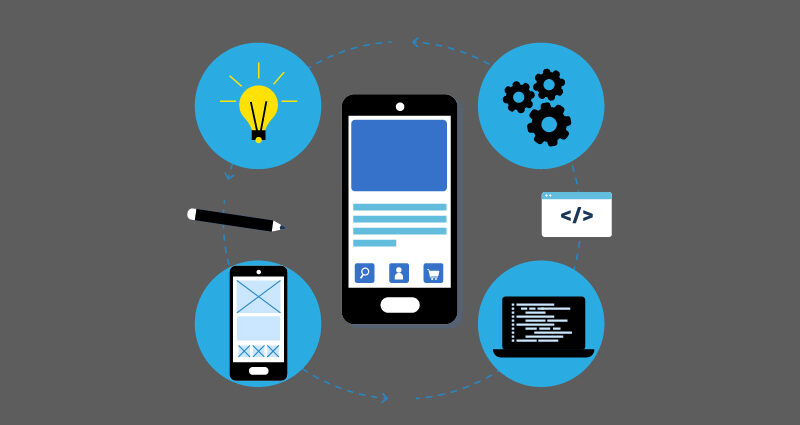Why Using React Native Makes More Sense from a Business Perspective in Most Use Cases
ReactJS, React Native, and Native development for any agile software, mobile app development software process, or product development are technologies that we have probably all heard about somewhere. While there isn’t a single optimal programming language for all situations, each language does a certain task better than another by the way it compiles.
Let’s look at some of the few advantages of using react native app development, a potent JavaScript framework that enables the creation, testing, and deployment of native Android and iOS applications development. Therefore, this framework may be thought of as a synthesis of all the benefits of JavaScript, React, and is strongly supported by Facebook. Following this blog post are some fascinating examples of businesses adopting or changing to native ecosystems.
Don’t be fooled by React JS here; to put it simply, it’s a solution that aims to give users a better mobile experience while also enabling developers to create native mobile apps in the most effective way.
React native app development makes it possible to share more than 80% of the code between Android application development and iOS devices, which makes front-end and agile software development 5 times faster than it would be using more conventional methods. Numerous well-known industry behemoths, like Facebook, Discord, LinkedIn, SoundCloud, etc., have validated and approved of this pace.
React Native Technology Benefits
Let’s look at the main benefits of adopting this technology and why React Native is referred to as the best option for developing mobile apps now, setting aside any drawbacks or room for progress; we will discuss that later in this post. According to Statista report of 2021 developers, Flutter is the most widely utilised cross-platform mobile framework worldwide. According to the poll, 42% of software engineers employed Flutter. The majority of mobile developers (around one third) use native tools, while the remaining two thirds employ cross-platform technologies or frameworks.
-
A Sense of Nativeness
By utilising their native components, such as the appearance of their respective icons and interfaces in Android and iOS devices, React Native avoids applications from losing their authentically “Native” look and feel. Digital services provider, can design fully functional programmes for any operating system with Bridging and can utilise whatever platform-specific languages they like. React Native is also highly recommended for the mobile app development software business as well as for creating intuitive and appealing app interfaces due to the fact that the entire framework is open-sourced. Even though some portions of the reused codes still need to be updated, the consistency is still admirable.
-
It Works Across Platforms
Because React Native is cross-platform compatible, we can write programmes in languages like Java, Kotlin, Objective-C, and Swift and use them with ease in our project. These cross-platform restrictions can be somewhat overcome by leveraging the shared code and a few tools, even if we must maintain distinct code bases for each code base written here.
-
Saving Time and Money
Not to exaggerate, but given how important a budget is to project management, the big news is that employing React Native for the development of any large project typically results in a savings of about one-fourth of the project budget, with the assistance of the web development team, of course.
-
More Rapid Ramp-Up
You’re already halfway through learning this new language if you’re just getting started with react native app development but have a firm grasp of JavaScript and the React syntax. The learning curve tends to flatten out, and you will quickly be able to deftly master mobile app development for both Android and iOS devices using the codebase.
Native App Development Technology Benefits
While we discussed the importance of React Native, let’s now turn our attention to native app development and discuss its benefits and reasons for being able to compete with React Native.
-
Improved Functionality of an App
Native mobile app development software and deployment requires a single codebase, namely Java for Android and Objective-C or Swift for iOS. Undoubtedly, while using React Native for the creation of cross-platform applications, fluid UI design is extremely feasible. However, when it comes to the performance of specific kinds of native Android or iOS apps along with sophisticated custom UI and animations, native app development is always king.
-
Rigidity Is Not All That Bad
The requirement of digital services provider, to develop two distinct applications for iOS and Android using their respective proprietary languages could initially appear to be a clear drawback. It’s not true! You will understand the critical benefit of native app development as you go deeper. Although the usage of strict languages reduces the chance of endless data structures and sluggish evaluation in general, they also produce clearer code and a more organised debugging process, which aid in preventing unintended consequences.
-
Documentation Is Accessible
Hybrid systems are lacking in very good and comprehensive documentation. This could get frustrating if this is your first time installing or testing these React Native apps. On the other hand, when working on native projects, we must ensure that we obtain updated documentation in order to start from scratch when each new change is implemented in the system.
-
Access to API
To be more precise, it’s application programming interfaces (APIs) that allow access to all the tools and frameworks developed for any particular platform and make mobile app development software look and feel native. They provide the hardware-software interaction, transferring media data without a network connection, and other things because they are a neighbourhood of the platform SDK. As a result, there are effective ways to use the existing programming interfaces to connect programmes to the required functionality.
Conclusion
In this cutthroat climate, many businesses choose mobile applications as targeted advertising channels while concentrating on revenue-generating operations. Therefore, even if the programme stays the same, it must be responsive, i.e. equally supported on iOS and Android devices, for better efficiency. The two solutions available to you, whose benefits we’ve described above, may not equally meet your business’s needs, but React Native is the ideal approach to do it when cost-efficiency is the top priority. The project scope, team expertise, and time constraints are also important considerations that should be made for the best-case scenario, therefore this is simply one criterion to be matched when deciding the final course of action. If you are looking for digital services provider, and mobile app development software, then get in touch with Creatix9.



